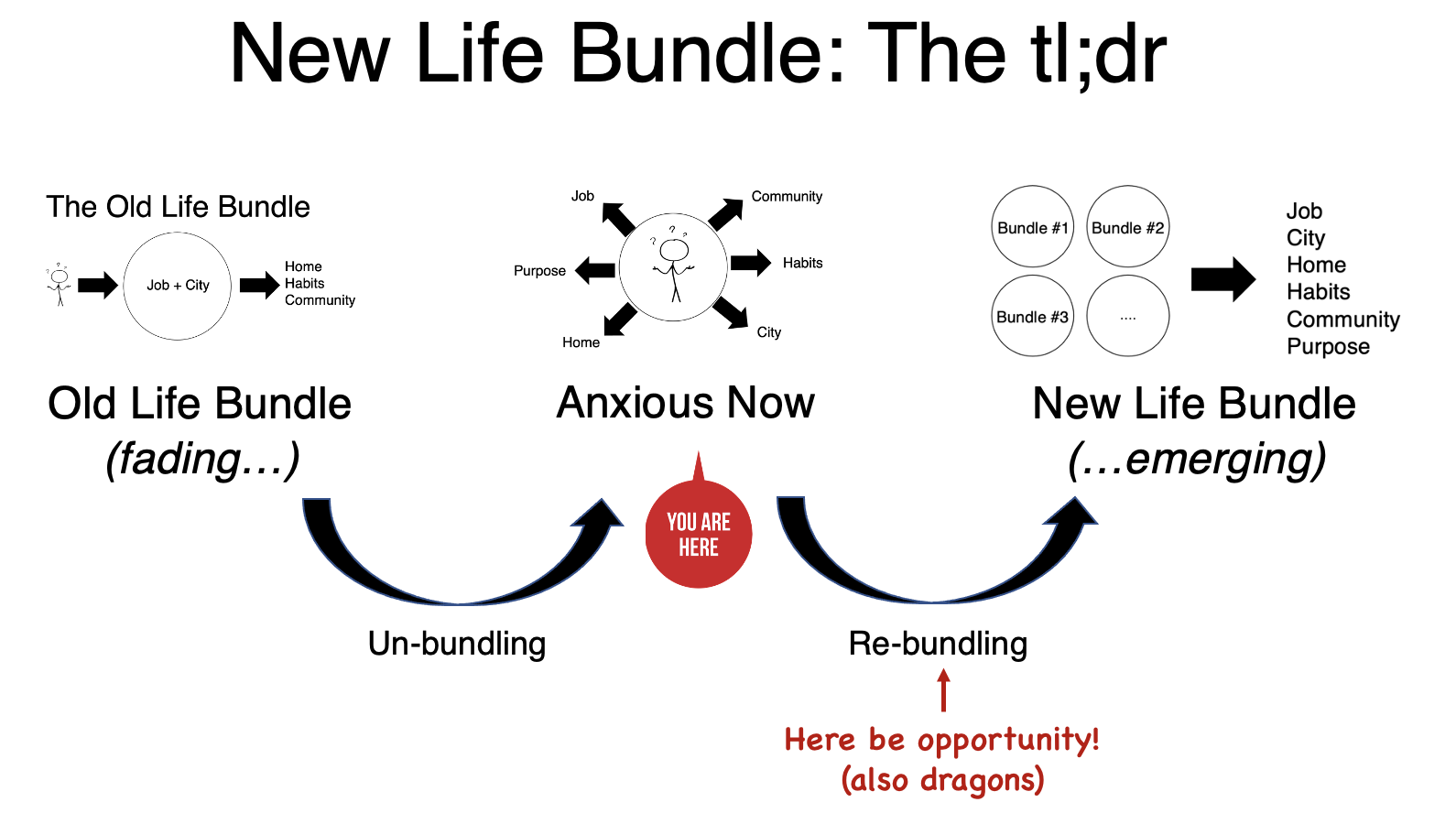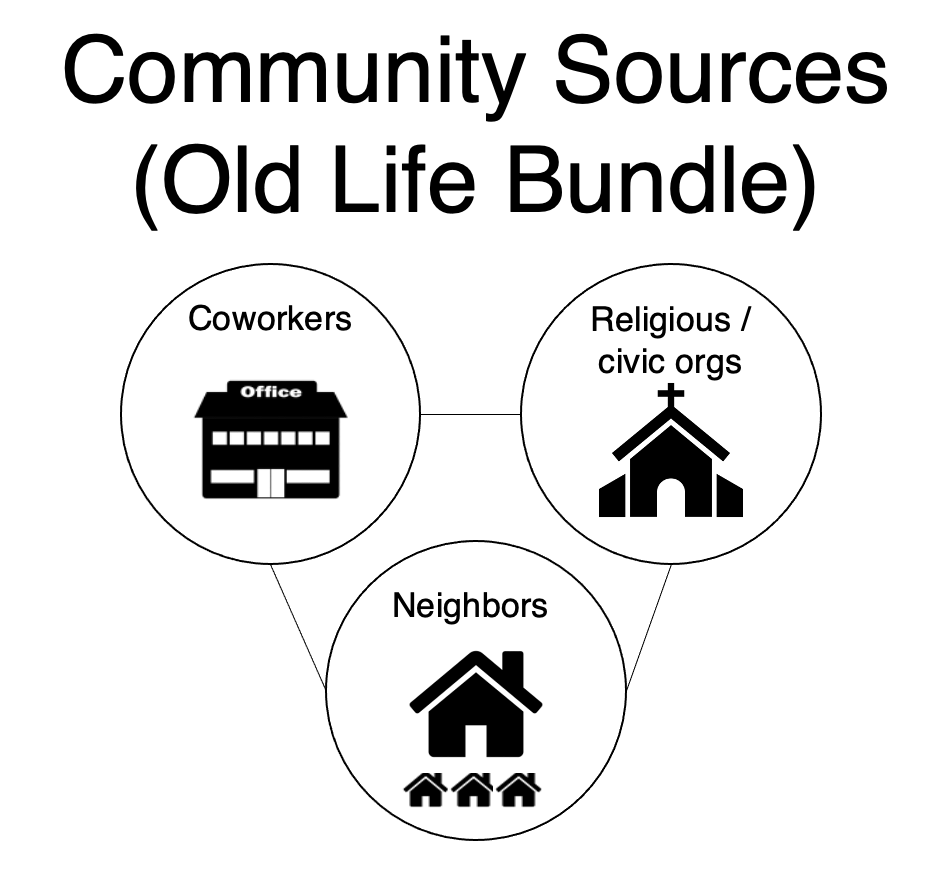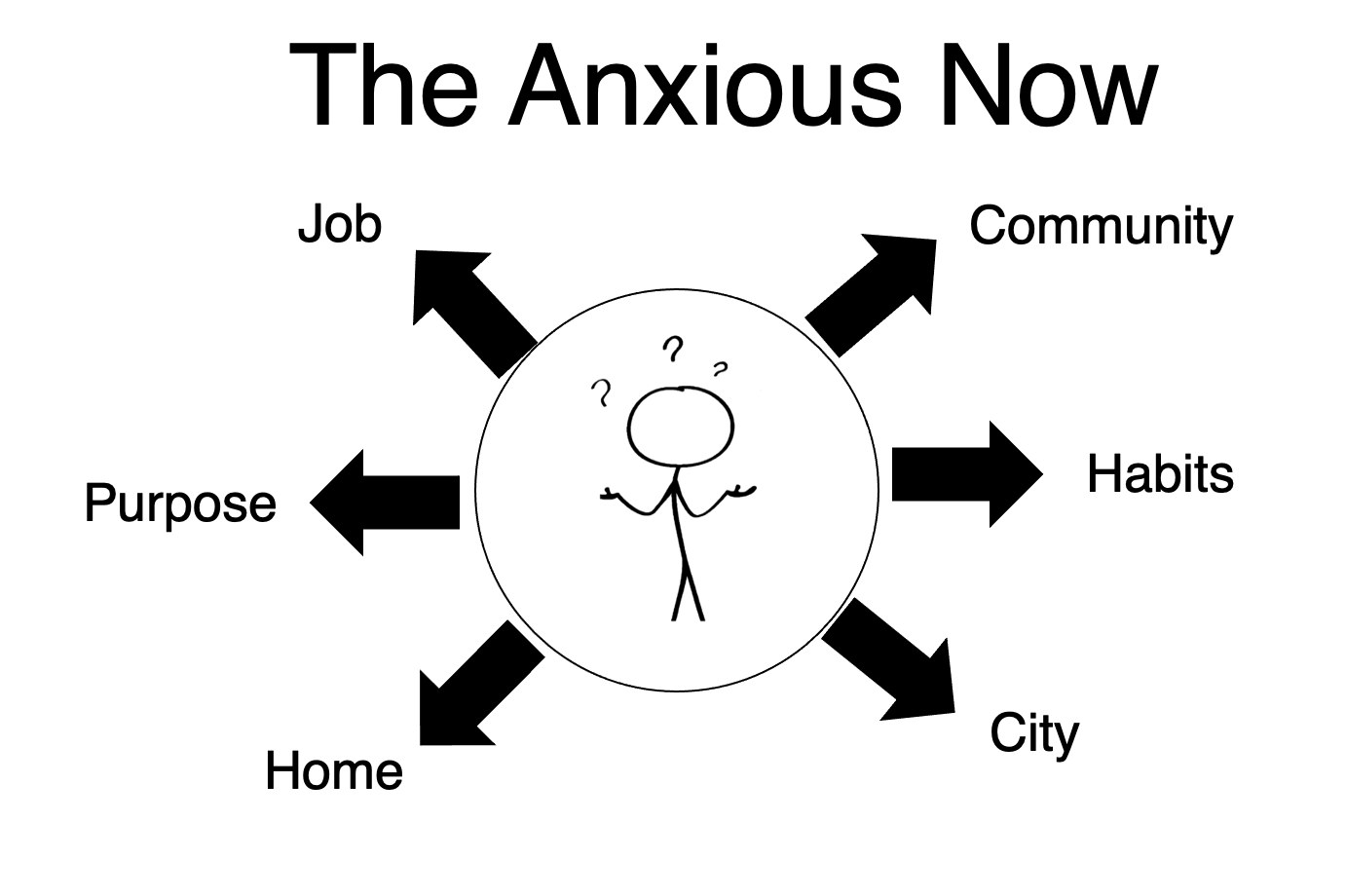Devon's clippings · Clipped: Thu-21-Jul-2022 · Original:
phil-levin.notion.site/phil-levin/Onwards-to-the-New-Life-Bundle-416e5fa81a684b67aca14199f204ac6c
Onwards to the New Life Bundle


Drag image to reposition
Onwards to the New Life Bundle
There's a big shift afoot.
It’s a shift in how we live, work, and find belonging.
I'm excited by it. And a bit anxious as well.
This series of posts is my attempt to get my head around it. If I've done my job here, by the end you'll both be examining how you live your own life and also thinking about opportunities to help others do the same.
Let's call the destination we are heading to the "New Life Bundle." And, to make sense of it, we'll first have to talk about where we came from before: The "Old Life Bundle."

It will all make sense by the end (maybe?)
The Old Life Bundle
The Old Life Bundle started with the job.

This usually went one of two ways:
var(--pseudoBefore--content)
Job → City: You got a job and it was in a particular city, so you moved there. ("I’m moving to San Francisco for this job at Twitter")
var(--pseudoBefore--content)
City → Job: You chose a city because of the jobs there ("I moved to San Francisco because I work in tech")
Either way, for many, the choice of where to live is all about the job (or the job of your spouse, etc). And Job + City becomes the primordial choice in your life bundle. All else flows from there.
Of course, it’s "Job + City" because the job was attached to a specific place. You were required to live where your employer (actual or prospective) was. For most people, this place was a city because that’s where employers are.
Your next choice was home: Where, specifically, in that city to live.
This choice had a major constraint attached to it: It needed to be commuting distance to that job. And given the architecture of our cities, that essentially boiled down to suburbs vs city center. And with each, a certain kind of housing stock and set of daily habits. Commute vs price. Car vs transit. Personal space vs urban energy. Cooking vs take-out. BBQs vs bars. You chose, but that choice was highly constrained with well-defined trade-offs.
Next: Community. That combination of home and job largely defined who your community in that city was going to be.
Three of the most important sources of community for people in the Old Life Bundle were neighbors, religious/civic organizations, and coworkers.

And none of these involve a particularly active choice. Your neighbors are randomly handed to you after you choose your home. Your religious organization is likely the closest church or two to your home. Your civic organization is chosen from whatever handful of civic organizations were active where you lived. Your coworkers are determined directly by your job.
So, in essence, all of these primary community sources more or less fall out of your choice of Job + City.
Sure, there were other sources for community. Maybe you get really into your local bridge club. Maybe a bunch of your college or high school friends live where you do.
But think about your parents, aunts, uncles: Who is their primary community? Odds are they are one of those three groups..
Job + City → Home → Community. In that order.
This is the Old Life Bundle.
The forces eating away at the Old Life Bundle
In the old life bundle, employers were the linchpin. They defined where people had to live (major employment centers), what homes were available to them (commuting distance from the office), who formed their core communities (coworkers, neighbors, civic/religious orgs).
There are a number of forces weakening the hold of that bundle:
var(--pseudoBefore--content)
Employers are less likely to take care of you. Pensions and long-term job security are a thing of the past. And employees are returning the favor by moving jobs more.
var(--pseudoBefore--content)
Civic and religious orgs are on a multi-decade decline.
var(--pseudoBefore--content)
Community is moving to the internet. Internet friends are becoming friends and competing with traditional place-based communities.
var(--pseudoBefore--content)
Homes in cities are increasingly unaffordable. Neighborhoods are aging, shutting the next generation out, and less of a source of community for newcomers.

The Old Bundle steadily recedes…
And now the big new catalyst: Remote work.
The pandemic radically accelerates the shift to remote work. A slow weakening of the old paradigm is now a stretched rubber band that no longer is able to go back to its original shape. Some of the 80m people currently working remotely in the US will go back to the office. There’s a lot of debate on how many, but everyone agrees it won't be all 80m of them. And even if they do go back to the office, they won't return with the same attitude toward the role of their employer in their life.
Remote work is the final blow to the Old Life Bundle. Without the linkage between job and city (and therefore job and home … and therefore job and community), the whole bundle falls apart.
The Anxious Now
"Anxiety is the Dizziness of Freedom"
- Søren Kierkegaard
Now people are able to select each of the components of their life bundle a la carte.
var(--pseudoBefore--content)
Place is no longer linked to job.
var(--pseudoBefore--content)
You can live in any city.
var(--pseudoBefore--content)
Home is now an open question mark with the traditional commute vs space trade-off no longer as relevant.
var(--pseudoBefore--content)
You can construct your day however you want.
var(--pseudoBefore--content)
Community doesn't "come for free" anymore, as it did with the Old Bundle lifestyle. You can't rely on a stable set of neighbors, coworkers and fellow churchgoers. You now have to actively seek out a community.
Whoa okay. Is this good or bad?
For those of us that spend 10 minutes picking from the dozens of options in the shampoo aisle, this is not necessarily a good development.

Fun Fact: Kierkegaard wrote that line about anxiety being the dizziness of freedom in the Walgreens shampoo aisle
The great thing about the Old Life Bundle is that it radically simplified the construction of your personal life bundle. It’s sort of like building a sandwich at Subway. Sure you have to choose which sandwich, which toppings, and whether you want it toasted. But those choices are constrained and all fall out from the original choice to go to Subway in the first place.
Now we are sitting in a supermarket, trying to make a meal with 10,000 potential ingredients, and lacking a recipe.
The meal you need to make is now your life. And you must choose from 100 employers, 1000 cities, 10,000 communities online and offline, and innumerable ways to construct your day.

Good luck.
This is our collective dizzying headspace. And it will be equal parts oppressive and freeing. Equal parts anxious and exhilarating.
Queue the New Life Bundle.
The New Life Bundle
️
"There are two ways to make money in business: You can unbundle, or you can bundle."
— Jim Barksdale
The New Life Bundle are the structures, institutions, and companies that will appear to help people ground themselves in this bonanza of lifestyle choice along multiple axes.
The New Life Bundle will be a grounding force. It will quell anxiety by constraining choice and providing a focal point for people to construct their life.
So what exactly is it? We don’t know yet! This is what we are going to explore.
In the Old Life Bundle, the "Job X City" was the focal point. What’s the focal point of the New Life Bundle?
My hypothesis: There won’t be a single bundle. There will be multiple options for how people construct their lives. What they will each have is a focal point in the center: The thing around which the other components of the bundle fall into place.
Here are a handful of candidate bundles I'll explore in upcoming posts.

Candidate bundle #1: New cities
A (remarkable) place as the focal point
People who decide to put place as the focal point of their life will demand great places. They won’t settle for this.

In this new world, I’m hyper bullish on "remarkable places" - places that are noteworthy and opinionated.
Existing remarkable places will be winners. I continue to be bullish on Manhattan. But there aren’t a lot of Manhattans out there.
So increasing demand for remarkable places will also beget supply of new places. And those places won’t have to appeal to the median person in the way that existing cities do (existing cities appeal to the median person because they are really appealing to employers and their broad base of employees).
These new places will be more opinionated, more notable, more (as the French maybe say?) sui generis:
Examples:
var(--pseudoBefore--content)
Along with Ryan Johnson and Jeff Berens, I founded a company called Culdesac which is building new remarkable places. Culdesac is the first post-car real estate developer in the US and is building car-free neighborhoods from the ground up. One early indication of place being a possible center of the New Life Bundle: Some future Culdesac residents tell us they are moving to Tempe (the location of our first neighborhood) because of Culdesac and plan to work there remotely.
var(--pseudoBefore--content)
The charter cities movement is seeing new life. Charter cities build new places as a way to experiment with new forms of governance. For some, the New Life Bundle might start with a charter city with a certain set of values and laws that appeal to them. Prospera and Nkwashi are two examples gaining momentum.
Candidate bundle #2: Decentralized cities:
"Scene" as the focal point
The other opportunity that remote work raises is not having to choose a single place as home at all.
This is something different than digital nomadism (which for all but a few, becomes lonely and exhausting).
A decentralized city hinges on a group of people spread across multiple places. Let’s call it a "scene."
Examples:
var(--pseudoBefore--content)
I’ve been working with Kift - an exciting company creating a decentralized city of van-lifers with a common set of values and ways of living. Their life will be spread across multiple homes (Kift clubhouses) with a single community of people.
var(--pseudoBefore--content)
You can think about Silicon Valley (the idea, not the place) as a sort of decentralized city. You can float between the coworking spaces of San Francisco, Miami, Austin and encounter a familiar set of people, values, and norms. Already, people split time between these cities without missing a beat because they are part of the same generalized scene. Erik Torenberg writes about this idea here.
Candidate bundle #3: Communal living
Squad as the focal point
Communal living, of various forms, is having a renaissance. And physical coliving communities are a candidate for focal points in the New Life Bundle. I write about this in detail in a separate blog for coliving practitioners called Supernuclear, but in this space we’ll zoom out a bit to some of the wider opportunities and implications.
What’s behind this: People crave social support structures. They crave squads. And with the dissolution of the Old Life Bundle, there’s not an obvious way to get these.
Intentional communities. Chosen families. Fictive kin. Same idea - a core of people at the center of your life.
Example:
var(--pseudoBefore--content)
Radish, a coliving community my partner Kristen and I started in Oakland is a community of 13 people. 12 of them no longer go into an office at all. The community itself is now the focal point of why we live in the Bay Area. Logan Ury, one of the Radish residents, writes beautifully about what this looks like in the NYTimes Modern Love column.
Candidate bundle #4: Cohort-based living:
A singular Goal as the focal point
This one may be best illustrated by an example. You know that New Years resolution you make every January to work out more? The one that you forget about every year by Jan 12th?
Suppose instead of just resolving to work out more, you structured your life -- temporarily-- around the goal.
You move into a house with a nice gym, trainer, and a dozen other people who share the same goal. You live there January through March. In that environment, you can’t help but accomplish your workout goal. The environment compels you.
This is cohort-based living. It’s centered around a particular goal. Goals or specific temporary areas of focus could become the focal point in the New Life Bundle.
Examples:
var(--pseudoBefore--content)
On Deck is a cohort-based professional career development program. It is not in-person but becomes a unifying goal and #1 focus participants over a discrete time period. An OnDeck program could be the center of a New Life Bundle for a specific period of time.
var(--pseudoBefore--content)
My friend Jonathan Hillis started Creator Cabins (as a DAO) in Austin. You go and quietly focus on a project for a month in a small community.
var(--pseudoBefore--content)
Hype House is another classic example of this: A temporary, intensive lifestyle choice focused on a singular goal.
What this should prompt
Here we are, dear reader, in the Anxious Now. The Old Life Bundle is in its death throes. The New Life Bundle has yet to fully appear.
Your assignment is to reflect on the following two questions:
var(--pseudoBefore--content)
How will you construct your New Life Bundle? What's at the center?
var(--pseudoBefore--content)
What business/organization do you need to start or join to help people move from the Anxious Now to the New Life Bundle as quickly and painlessly as possible? Where are the opportunities in this new world and where does your work fit?

Does it make some sense now at least?
Okay. Until next time.